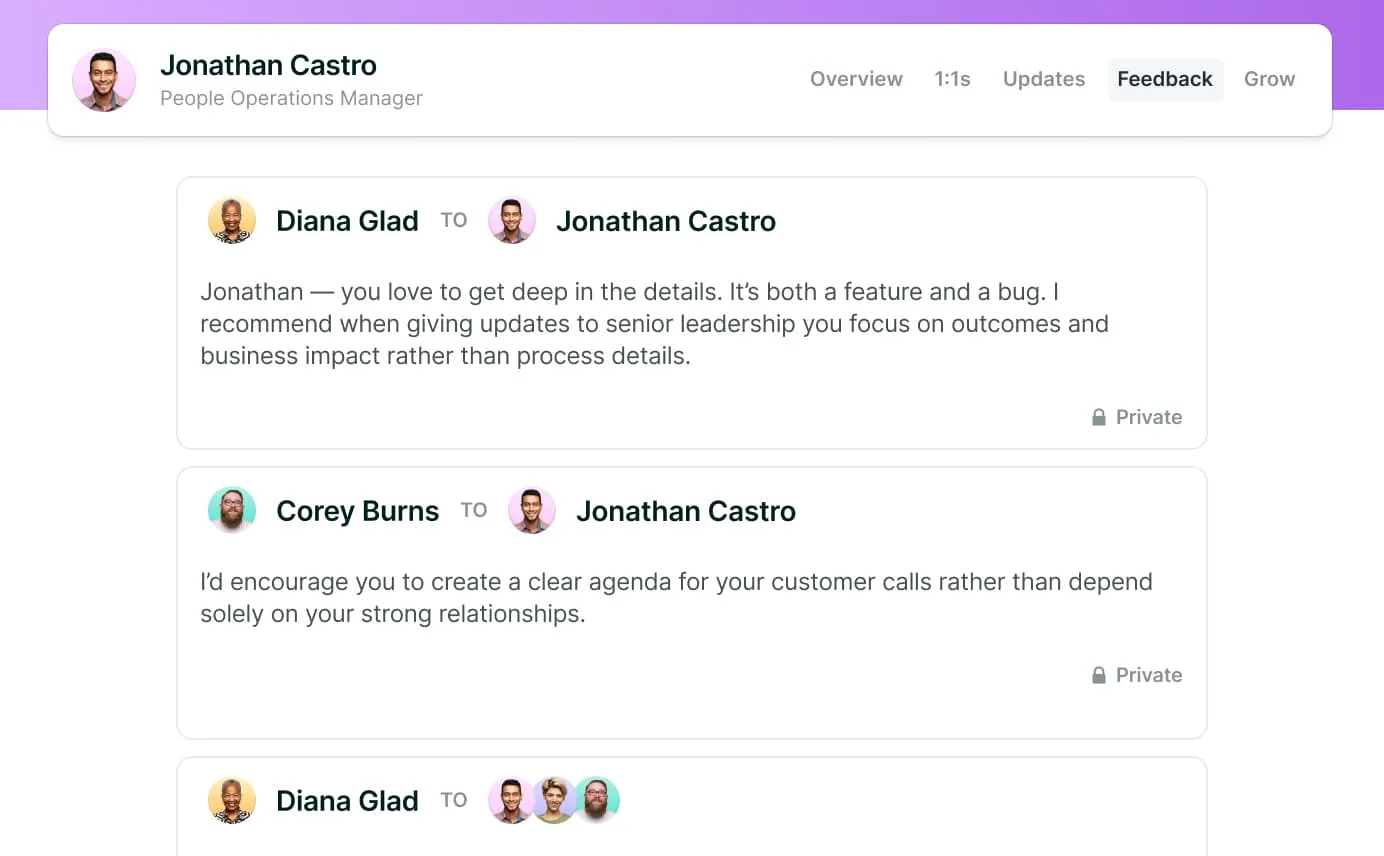Employees want to speak up — but sometimes, it’s easier to stay silent. Research from AllVoices found that 84% of employees had one or more concerns but didn’t share them with HR. One of the main reasons? There was no way to give their feedback anonymously.
Done right, anonymous employee feedback can help encourage honesty, promote inclusivity, and ensure participation from as many employees as possible. But it also comes with some challenges, including the risk of getting unconstructive, negative feedback. Meeting the challenges head-on — by conducting anonymous feedback surveys in the right way — can help HR leaders create a company culture that gives every employee a voice.
Let’s take a closer look at the benefits — and challenges — of anonymous feedback, so the next time you integrate this kind of feedback into surveys, you can be confident it’s done right.
What is anonymous employee feedback?
Anonymous employee feedback lets people submit their opinions or suggestions while remaining confidential. This helps boost feelings of psychological safety, creating a safe space where employees can share their opinions freely.
Once upon a time, this kind of feedback was typically collected as written comments submitted in a suggestion box in the office. Nowadays, it’s usually collected via HR tech, third-party survey tools, or anonymous suggestion inboxes.

The Pros and Cons of Anonymous Feedback
Anonymous feedback comes with plenty of benefits — but also its fair share of challenges.
Pros of Anonymous Employee Feedback
There are plenty of reasons why anonymous feedback is such a powerful way to uncover employee opinions. Here are some of our favorites.
Encourages Honesty and Transparency
Some employees are comfortable sharing their thoughts freely, while others prefer to keep their opinions to themselves. Both these approaches are valid, but companies need to ensure all employees have opportunities to give their honest feedback. Sometimes, the only way to achieve this is to offer anonymity.
Without it, some employees might not feel comfortable giving their honest feedback. They might worry that truly candid feedback could be perceived as critical, ungrateful, or difficult. Collecting feedback anonymously makes it easier for employees to express their opinions, which is crucial for companies to identify and then address any issues or concerns.
Samantha Hoffmann, senior human resources manager at Aspen Skiing Company, explained that anonymous surveys are a diplomatic way to take suggestions — with no biases. “It’s a great platform to get new ideas and hear about someone’s experience as an employee, [whether they’re] brand-new or a 30-year veteran,” she said.
Reduces Fear of Judgment or Retaliation
Some employees may worry that they’ll be judged if they share their true feelings. As a result, during non-anonymous surveys, they might only include filtered comments. Others may be concerned that their comments may lead to negative consequences or retaliation.
“I'm always disappointed to hear employees feel their job could be on the line for completing a survey,” said Emma Bindbeutel, former head of people operations at ad tech company Choozle. “Why should a company ask for feedback if they don’t want honest feedback?” Bindbeutel asked. “Leaders who are reading the results need to keep an open mind and see the feedback as areas to improve, and to not get frustrated by.”
It can be disheartening for HR teams to discover that employees aren’t offering feedback due to the fear of judgment or retaliation. But this is a strong indicator that it’s time to take a look at your company culture as a whole.
Promotes Inclusivity
Some employees may feel marginalized or just be hesitant to share their thoughts and opinions. A meta-analysis published in the Journal of Business and Psychology in 2022 found that employee silence is influenced by a range of factors, including psychological safety, individual dispositions, and job perceptions.
By offering the option of anonymous feedback, companies can promote inclusivity and help create a feeling of psychological safety. Over time, this can create a more representative feedback process, where all employees have a voice.
Cons of Anonymous Employee Feedback
There’s always a flip side. Anonymous feedback comes with a few downsides, but many of these can be avoided with the right approach.
Difficulty Following Up on Specific Points
One challenge with anonymous feedback is that it often removes the ability for HR teams and managers to follow up on points raised. For example, if managers are looking for feedback from their teams or HR is looking for ways to improve career development, anonymous feedback makes it difficult to ask respondents what steps to take next.
One way to get around this, suggested Hoffmann, is to offer an anonymous survey with an option to be contacted by HR. The right feedback software makes this possible. For example, Lattice Engagement gives HR teams the ability to reply to anonymous comments. This allows HR to close the loop on employee feedback by either acknowledging comments or asking for more information, all while employees remain anonymous.
Lack of Actionable Details
Occasionally, offering anonymous feedback may encourage the kind of negative behavior seen in anonymous comments on the internet: mean-spiritedness. If this happens, potentially constructive feedback can get lost in an unkind delivery.
HR teams may also find it hard to uncover any actionable details from these kinds of comments because employees may simply be using anonymous surveys as an opportunity to vent.
To avoid this, combine structured questions with rating scales. This helps ensure that you collect actionable data while also allowing employees to share their thoughts and opinions. Including prompts like “What specific changes would you like to see?” can help encourage employees to provide specific details rather than unproductive comments.
Potential to Foster Distrust
Unfortunately, anonymous surveys can sometimes create distrust and reinforce the idea that it’s risky to speak up. This can be especially true in smaller teams or organizations, where people may start to wonder what’s being said behind closed doors. Employees may also feel like their comments aren’t truly anonymous and can be traced back to them.
When these kinds of surveys are used, HR departments need to clearly communicate anonymity policies and explain how employee identities are protected. For example, Lattice Engagement offers the option to choose between two levels of anonymity: standard and enhanced, designed to protect smaller groups of respondents.
Why Anonymous Employee Feedback Matters in the Workplace
The promise of anonymity — at least in some capacity — is a step in the right direction of giving everyone a voice, said Liz Ratto, chief people officer at Cedar, a healthcare technology company.
“Even in the most inclusive and respectful companies, there are power dynamics and intrinsic biases in all of us that cause us to react to people in certain ways,” Ratto explained. “Failing to acknowledge those realities or trying to only overcome them via policy — such as requiring all feedback to be attributed — lets us off the hook of actually confronting them and doing the work to keep them in check.”
Confronting and resolving the realities that come with anonymous comments can also help boost employee engagement. By encouraging this kind of open feedback, companies can better understand the employee experience and gather the kinds of insights needed to check if engagement strategies are working.
This also helps improve employee retention and growth, as Kristen McGill, former chief people officer at financial empowerment platform ZayZoon explained: “In order to effectively retain and grow your team, you must truly demonstrate that you care about them as people, that you're going to be transparent, and that you're going to give your employees a voice.”
The Impact of Anonymous Feedback on Company Culture
When and how to request anonymous feedback is influenced by the communication patterns already observed at your company. Do employees consistently display healthy, open communication, or are hushed “venting sessions” more common? Once you’ve identified these patterns, you can start building feedback strategies tailored to your organization’s collective personality.
These patterns aren’t set in stone, either — they can change over time. And when they do, HR teams need to be flexible and adjust their feedback methods accordingly.
“It's more critical to observe and track changes in how your team is communicating than it is to try to adhere to limited communication norms,” Ratto said. “If people who used to directly voice their feedback become hesitant to do so, or if you used to have dynamic Town Hall meetings with plenty of people walking up to the microphone, then future meetings are full of crickets, those are trends to dig into.”
Another approach is to turn to your company values. For example, Cedar’s value of positivity is used to influence its feedback strategy. “Because of this value, as well as Cedar’s commitment to supporting inclusion, we need to create an open, transparent environment where we can hear all of our team members’ voices regardless of how they're comfortable making them heard,” Ratto said.
This kind of approach means anonymous employee surveys aren’t always the right choice, so it’s important to consider when to use this option in the workplace.
Context Matters: When to Use Anonymous Feedback
The type of feedback you’re looking for is, in part, going to dictate the best approach for obtaining it. It’s unrealistic to expect beneficial results if the ways you source feedback are identical across the board, said Ratto. “You risk stifling the evolution of the organization or the development of the person if there is only one way to be in every circumstance.”
The first thing to think about is why you’re seeking feedback. For example, if leaders want to collect broad opinions on company-wide changes or ask for honest opinions of the company’s culture, anonymous feedback can allow employees to share their thoughts freely.
Anonymous feedback is typically suited to surveys on:
- Company culture
- Employee engagement
- Organizational changes
- Sensitive topics like discrimination or harassment
Other surveys that aren’t a good fit for anonymous feedback include:
- Exit surveys
- Stay interviews
- Onboarding surveys
- Performance management
- Training and development needs
It’s not always an either-or situation. Often, a blended, hybrid approach is best. For example, during Choozle’s twice-yearly pulse surveys, an anonymous but open approach works best. “We have learned to keep our surveys anonymous, but provide an area for the employee to leave their name if they wish to meet with HR to further discuss their feedback or idea,” said Bindbeutel. “The follow-up has always been beneficial.”
The Importance of Consistency
Offering options for both anonymous and non-anonymous feedback is important, but so is creating consistency for employees. Changing the way you request feedback too often might make employees feel apprehensive, uncomfortable, or feel like their feedback isn’t taken seriously.
If you go with a hybrid approach, make sure that’s communicated to employees. Share what the plan is, why and how you landed there, and exactly what HR intends to do with the survey results.
How to Collect Anonymous Employee Feedback
Anonymous surveys can easily be integrated into your regular survey cadence. Here’s how.
1. Define your objectives.
Before deciding whether a survey needs to be anonymous or not, it’s important to define the objectives of the survey. For example, is the goal to improve employee satisfaction, uncover upward feedback for managers, or gather general suggestions for improvements?
Then, decide if the survey will be company-wide or specific for certain departments or teams. It’s also important to decide what actions you’ll take as a result of any responses.
2. Plan your survey.
When planning your survey, decide whether to use an existing template or a new, custom survey. Include a blend of questions, for example, multiple-choice or those rated on a Likert scale. It’s also a good idea to include comment boxes so employees can share additional details if they want to.
In addition to regularly scheduled anonymous surveys, you might decide to offer employees the opportunity to submit suggestions at any point via a feedback tool, online surveys, or anonymous email inboxes.
3. Use the right HR tech.
HR tech has become a key way for HR teams to collect and analyze all kinds of employee feedback, including anonymous surveys. For example, Lattice aggregates survey responses, so scores and comments can’t be linked to the person who submitted them. During a survey, there are also anonymity reminders so respondents know their comments are completely anonymous.
4. Analyze your results (and take action).
Analyzing your results is one of the most crucial aspects of any survey, but it can be time-intensive. HR tech is one way to speed up the process.
By aggregating anonymous comments on key themes, valuable insights, and recommended actions, Lattice AI can help. This approach saved the HR team at software solutions company Weave 30 hours per engagement survey. It also created a consistent process: “There’s a consistency from the analysis,” explained Kolby Jensen, director of HRBPs and employee experience at Weave. “That kind of consistency isn’t always possible with a team who may interpret the same comment in different ways.”
Once results have been analyzed, it’s important to communicate the findings, address any issues, and share action points with employees. That way, they know they’re heard and appreciated, rather than feeling like they’re screaming into the void.
{{rich-highlight-1}}
Build a culture of feedback with Lattice.

Feedback matters. Sometimes, the feedback offered within anonymous surveys matters most of all. These raw, unfiltered comments present a powerful opportunity for companies to learn what their employees really think. Once uncovered, these thoughts can be used to start building a culture with the employee experience at its heart.
By offering anonymous surveys and the opportunity to respond to them, Lattice makes it easy to close the employee feedback loop. Powerful analysis tools also help uncover the key themes and actionable insights needed for informed decisions and positive change.
Ready to hear what your employees have to say? To learn how Lattice streamlines the creation and analysis of anonymous surveys, request your free demo.








